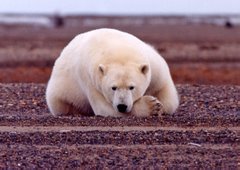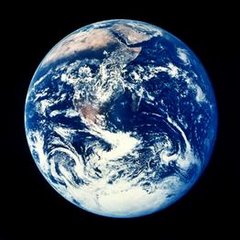
(photo L to R: Hazel Apok, Kotzebue, Dixie Hutchinson - KNBA radio, Hannah Loon, Selawik. Mothers for Alaska members Hazel and Hannah gave a wonderful radio interview before testifying at the Climate Hearings.
Testimony of:
Ms. Hannah Paniyavluk Loon
Climate Change
April 2007
Hello, my name is Hannah Paniyavluk Loon, born and raised in Selawik, Alaska, a large village of about 850 plus residents. I am a part-time Rural Development student with the University of Alaska, a mother of three children ages 29, 28, and 21. I am currently employed by the NANA Regional Corporation as a Shareholder Relations Liaison, based out of the Red Dog Mine.
I thank the planners for allowing Mothers of Alaska to speak to the Commission on Climate Change and to the federal agencies and invited guest speakers. My family and I hunt, fish and gather from the land and we provide for many elders and neighbors. As hunters and gatherers, we are outside most of the time. We are keen observers of our natural world and have noticed a change in the climate over the past 10 years.
The land, small sloughs, small willow valleys, lakes, and the game that lives in them are what sustain our daily living in Selawik. We also rely on migratory birds that come to feed and breed on the wetlands of the Selawik River drainage.
I interviewed Mildred Foster, chair-woman of the Selawik Elders Council. She is a high harvester of white fish and pike. These are her comments about climate change:
“For the last five years, my brother and my family went to camp to harvest white fish and much to our dismay and disappointments, the processed fish did not dry and all have been given to families that have dogs. We had one long net and two short nets to catch fish. We filled several drying racks filled with fish we had cleaned and cut to dry. There were approximately 30 or more fish in each rack.
To do this, we brought our tent, wood stove, nets, food, and bedding and spent one and a half week to check the nets, clean, and fillet to dry the fish. We brought the fish home and hung under our storage fish racks to dry more. It rained for such a long time and the fish did not dry properly. Instead, it all went to waste because it was not fit for human consumption.
We experienced this for five years. Not only our family was affected, but also those who depend on us to give them fish. They live in Buckland, Kotzebue, Fairbanks, Shungnak and Anchorage.”
When asked about other changes she observed, she commented:
“As soon as the ice goes, we have to rush to gather fish from our nets while there are no bugs. I also observed that when we check our nets in the morning in late June, the water is already too warm, so the fish dies and decays in the water from the sun’s heat. These fish also go to waste and are not fit for human consumption.
Blueberries do not grow like before; my daughter had to travel far above Selawik River to pick blue berries. I went to Shungnak to pick blueberries.”
Selawik people need gas to start off their gathering and have sold a Ziploc bag of white fish for $13 per bag and $17 per bag for dried pike. One Ziploc bag of salmonberries goes for $25 or $250 for a 5 gallon bucket. This serves as an economy for the residents and provides for those who have no means to go out, primarily the elders. Otherwise, most of what we do gather is shared with family and friends as we have for centuries.
Mildred also stated that there is water already between Kiana and Selawik, a narrow pass where the Kobuk 440 mid-distance dog race plans to travel on. This is a winter trail for Selawik and Kiana residents. Also, there is water on the mouth of the Buckland River drainage and on the Selawik River drainage. Signs like these make travel by snow machine very dangerous.
Two years ago, we lost 2 young girls and one male adult who fell under the ice near the village. They fell under the ice that was always considered a solid area in the past, but wasn’t. The people we lost were merely hunting for geese just a bend away below Selawik River about 1 mile. They had no reason to believe the ice would not hold them as it always had before. This sad incident also left an elderly woman with no hunting provider.
This fall, my cousin, Emma Ramoth asked me to cut up fish in my house and hang them in the furnace room which I did. I asked myself and my daughter, is this adaptation for us to do regarding climate change? When our fish do not dry in fall due to abnormal heavy rains, do we change to cutting our fish in the house and later hang them outside?
I thank you for listening and hope our concerns will make a difference in your deliberations to make our environment safe to travel, and harvest game how we used to in the past. Please educate us and provide information about climate change that is easy to understand. Although we are few in number, we are willing to make simple changes to conserve electricity and fuel as a statement to the rest of the United States about their personal responsibility to reduce the amount of gas emissions to the environment.
Pease visit us in the villages and hold hearings on about their observations of climate change. We are extremely concerned and want to hear what is going on.
Again thank you for listening to Mothers for Alaska and hearing our plea for understanding and willingness to work with you to preserve our ways.



1 comment:
I enjoyed reading your article and look forward to more in the future.
Post a Comment